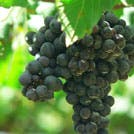
Shiraz (which is essentially Syrah) is a dark-skinned grape grown throughout the world and used primarily to produce powerful red wines.
Wines made from Syrah are often powerfully flavoured and full-bodied. The variety produces wines with a wide range of flavor notes, depending on the climate and soils where it is grown, as well as other viticultural practices chosen. Aroma characters can range from violets to berries (usually dark as opposed to red), chocolate, espresso and black pepper. No one aroma can be called "typical" though blackberry and pepper are often noticed. With time in the bottle these "primary" notes are moderated and then supplemented with earthy or savory "tertiary" notes such as leather and truffle.
"Secondary" flavor and aroma notes are those associated with several things, generally winemakers' practices (such as oak barrel and yeast regimes).
History
It is called Syrah in its country of origin, France, as well as in the rest of Europe, Argentina, Chile, New Zealand, Uruguay and most of the United States. The name Shiraz became popular for this grape variety in Australia, where it has long been established as the most grown dark-skinned variety. In Australia it was also commonly called Hermitage up to the late 1980s, but since that name is also a French Protected designation of origin, this naming practice caused a problem in some export markets and was dropped. The name Shiraz for this grape variety is also commonly used in South Africa and Canada. It seems that many of the legends of Syrah's origins come from one of its many synonyms - Shiraz. Since there also is a city in Iran called Shiraz, where the famous Shirazi wine was produced, some legends have claimed that the Syrah grape originated in Shiraz, and was brought to Rhône, which would make Syrah a local French synonym and Shiraz the proper name of the variety. Whatever you call it, it is one of the world's most renowned grapes for making Big Bold Red Wine.
In Australia
The Syrah grape was introduced into Australia in 1832 by James Busby, an immigrant who brought vine clippings from Europe with him, and it is almost invariably called Shiraz. Today it is Australia's most popular red grape, but has not always been in such favor; in the 1970s, white wine was so popular that growers were ripping out unprofitable Shiraz and Grenache vineyards, even those with very old vines. Many factors, including the success of brands like Lindemans (part of Foster's Group) and Jacob's Creek in the UK, as well as Rosemount in the US and UK, were responsible for a dramatic expansion of plantings during the 1980s and 1990s; a similar trajectory occurred in California. However, the biggest factor in this expansion during the 1990s was a federal government tax subsidy to those planting new vineyards.
Shiraz is now the most planted variety in Australia. Australia thus has the world's second largest plantations of Syrah/Shiraz, after France. Victorian regions include Heathcote, roughly 1.5 hours north of Melbourne. Cooler climate regions such as Western Australia's Margaret River produce Shiraz with marginally less alcohol content and often in a more traditional French style.
A well known example of the Shiraz grape in Australian viticulture is the Penfolds "Grange". This wine was created by winemaker Max Schubert in 1951, and has a reputation of aging well. The Penfolds Grange is predominantly Shiraz, but often includes a small quantity of Cabernet Sauvignon. It is usually a multi-regional blend of quality South Australian Shiraz, with the Barossa Valley playing an important role, and matured in new American Oak. Other well known Australian Shiraz wines include, the Henschke "Hill of Grace" and the Penfolds "RWT".
Recently, Australian Shiraz producers have started to add up to 4% Viognier to their Shiraz to add apricot tones to the wine's nose and palate. With such a small percentage added, the producer wasn't obliged to declare the blend on the label. In the past 5 years however, it's becoming increasingly fashionable to label the wine Shiraz Viognier as Viognier gains consumer acceptance in the market place. The practise of blending Viognier with Syrah has actually been common for years in the Northern Rhône Valley region of Cote-Rotie. Shiraz is also the "S" in "GSM" (Grenache-Shiraz-Mourvèdre), which is common Australian designation for a Châteneuf-du-Pape-like blend.





